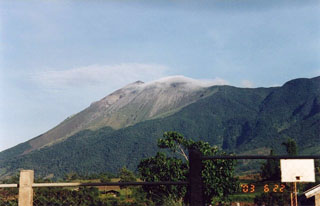Report on Kanlaon (Philippines) — 15 January-21 January 2025
Smithsonian Institution / US Geological Survey
Weekly Volcanic Activity Report, 15 January-21 January 2025
Managing Editor: Sally Sennert.
Please cite this report as:
Global Volcanism Program, 2025. Report on Kanlaon (Philippines) (Sennert, S, ed.). Weekly Volcanic Activity Report, 15 January-21 January 2025. Smithsonian Institution and US Geological Survey.
Kanlaon
Philippines
10.4096°N, 123.13°E; summit elev. 2422 m
All times are local (unless otherwise noted)
The Philippine Institute of Volcanology and Seismology (PHIVOLCS) reported continuing eruptive activity at Kanlaon during 14-21 January. The seismic network recorded 4-17 daily volcanic earthquakes that included 1-5 periods of volcanic tremor lasting five minutes to one hour and 36 minutes; volcanic tremor was not detected on 17 January. Average daily sulfur dioxide emissions ranged from 2,302 to 5,222 tonnes per day. Weather clouds prevented views on 14 and 17 January. There were 2-5 periods of ash emissions during 15-16 and 18-21 January, each as short as two minutes and as long as three hours and seven minutes. Gas-and-steam emissions and those occasionally containing ash rose as high as 300 m above the summit and drifted SW and W. Plumes were voluminous on 21 January.
The eruption continued to impact residents. The National Disaster Risk Reduction and Management Council (NDRRMC) report issued at 0800 on 21 January stated that 9,869 people (3,117 families) were spread across 23 evacuation centers and another 8,376 people (2,648 families) were staying elsewhere. The Alert Level remained at 3 (on a scale of 0-5); the public was warned to stay 6 km away from the summit and pilots were warned not to fly close to the volcano.
Geological Summary. Kanlaon volcano (also spelled Canlaon) forms the highest point on the Philippine island of Negros. The massive andesitic stratovolcano is covered with fissure-controlled pyroclastic cones and craters, many of which are filled by lakes. The largest debris avalanche known in the Philippines traveled 33 km SW from Kanlaon. The summit contains a 2-km-wide, elongated northern caldera with a crater lake and a smaller but higher active vent, Lugud crater, to the south. Eruptions recorded since 1866 have typically consisted of phreatic explosions of small-to-moderate size that produce minor local ashfall.
Sources: Philippine Institute of Volcanology and Seismology (PHIVOLCS), The National Disaster Risk Reduction and Management Council (NDRRMC)

